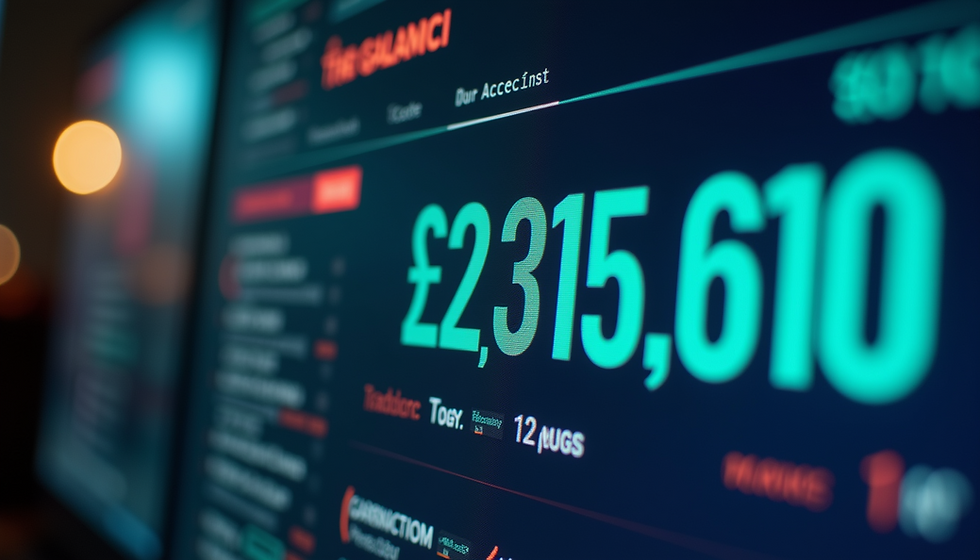Deciphering the Costs: A Comprehensive Guide to Tradovate Fees
- Nakul Patel

- Jan 28, 2024
- 3 min read
In this comprehensive guide, we will delve into the world of Tradovate fees, shedding light on the various types of fees charged, the factors that influence fee structures, and how Tradovate fees compare with those of other trading platforms. By the end of this article, you will have a clear understanding of the costs associated with trading on Tradovate, enabling you to make informed decisions about your trading activities.
Key Takeaways
Understanding the different types of fees charged by Tradovate.
Factors such as trading volume and account balance affect the fee structure on Tradovate.
Comparing Tradovate fees with those of other platforms can help traders make cost-effective decisions.
Being aware of hidden fees and additional charges is essential for accurate cost assessment on Tradovate.
Understanding the fee structure is crucial for determining the overall cost of trading on Tradovate.
Understanding Tradovate Fees
Types of Fees Charged
When trading with Tradovate, it's crucial to understand the various types of fees that can affect your overall trading costs. Commission fees are charged per contract and vary depending on the type of membership you have. In addition to commissions, traders may encounter exchange fees, which are set by the futures exchanges and are the same for all members.
Commission Fees
Exchange Fees
Regulatory Fees
Platform Subscription Fees
Data Fees
Lastly, traders should be aware of potential regulatory fees, which are mandated by financial regulatory bodies, and data fees, which cover the cost of market data. Platform subscription fees are also applicable if you opt for enhanced features or services. Understanding each of these fees will help you manage your trading expenses more effectively.
Factors Affecting Fee Structure
The fee structure at Tradovate is influenced by a variety of factors, each playing a pivotal role in determining the overall cost to the trader. Account type is a primary determinant, with different levels of service and access commanding varying fees.
Another significant factor is trading volume; higher volumes often lead to reduced fees per contract, benefiting active traders. Additionally, the choice of membership plan can affect fees, with premium plans offering lower transaction costs in exchange for a monthly or annual fee.
Account Type
Trading Volume
Membership Plan
Market Data Subscriptions
Comparing Tradovate Fees with Other Platforms
When evaluating Tradovate's fee structure, it's essential to consider how it stacks up against other trading platforms. Cost efficiency is a critical factor for traders, and a direct comparison can reveal where Tradovate stands in the competitive landscape.
Commission Fees: Tradovate may offer lower commission fees compared to some platforms but could be higher than others that provide commission-free trades.
Subscription Fees: Unlike many platforms, Tradovate offers a subscription-based model that can lead to savings for high-volume traders.
Data and Exchange Fees: These are often similar across platforms, but Tradovate's all-inclusive subscriptions can offer additional value.
Here's a succinct comparison table highlighting key fee differences:
*Commission varies based on membership plan and volume.
Conclusion
In conclusion, understanding the costs associated with Tradovate fees is essential for traders to make informed decisions. By deciphering the various fees and charges, traders can effectively manage their trading expenses and optimize their overall trading experience. With this comprehensive guide, traders can navigate the complexities of Tradovate fees with confidence and clarity.
Frequently Asked Questions
What are the different types of fees charged by Tradovate?
Tradovate charges various types of fees, including commission fees, exchange fees, platform fees, and other regulatory fees. Each fee type may have different rates and structures.
How do factors like trading volume and account type affect Tradovate's fee structure?
Trading volume and account type can impact the fee structure at Tradovate. Higher trading volumes may lead to volume-based discounts, and different account types may have varying fee schedules.
Can I compare Tradovate's fees with those of other trading platforms?
Yes, you can compare Tradovate's fees with other trading platforms to evaluate their competitiveness. It's important to consider the overall value provided by each platform, not just the fees.
What are commission fees, and how are they calculated at Tradovate?
Commission fees are charges for executing trades, and they are typically calculated based on the number of contracts traded or the total dollar value of the trade. Tradovate may have different commission structures for various products.
Are there any hidden fees or additional charges at Tradovate?
Tradovate aims to provide transparent pricing, but it's important to review the fee schedule and terms of service to understand any potential additional charges or fees that may apply.
How can I minimize the impact of fees when trading on Tradovate?
Traders can minimize the impact of fees by understanding the fee structure, optimizing their trading strategy, and taking advantage of any available discounts or promotions offered by Tradovate.


Comments